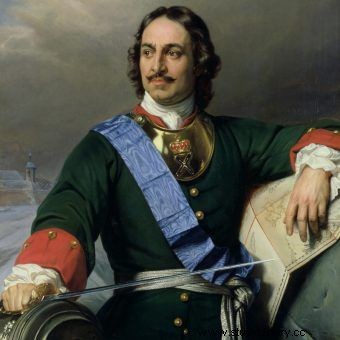
Peter I in the portrait of Paul Delaroche.
Peter I the Great (1672-1725) - the Tsar of Russia in 1682-1725 of the Romanov dynasty. He was born on June 9, 1672 in Moscow. He was the son of Tsar Alexei I Romanov and Natalia Naryshkin. When he was four, his father died, and his half-brother Fyodor III Romanov took the throne. Six years later, in 1682, Fyodor's death led to a conflict over the crown between Peter and his next half-brother, the mentally retarded Ivan. Eventually, they were both elevated to the throne, and their sister Zofia became regent (she held this position until 1689). The brothers co-ruled until 1696, when Ivan V died. Meanwhile, in 1689, Piotr married Eudoxia Lopukhina. The not-so-successful marriage ended in 1698 with Eudoxia being sent to a monastery.
In 1697, he joined the Polish election, supporting the election of August II the Strong as the king of the Polish-Lithuanian Commonwealth. Winner of the Northern War with Sweden (including the decisive Battle of Poltava in 1709). Under the Treaty of Nystad in 1721, it occupied a wide strip of the Baltic coast, stretching from Karelia to Livonia.
Soon after Ivan's death, Peter achieved his first single victory, defeating the Turks and capturing the Azov fortress. It made him realize the need to build a strong fleet. In the years 1697-1698 he traveled through Western Europe, officially in order to reactivate the Holy League. During it, however, he also got to know the Western lifestyle and customs. He also studied modern technical thought, including shipbuilding. Upon his return, he began to make changes in Russia, forcing the boyars to shave their beards and adopt Western dress, and also (in 1700) adopting the Western calendar.
In the following years, he carried out further, far-reaching reforms. He abolished the Moscow Patriarchate, refraining from appointing a new patriarch in 1700. In its place, in 1721, he established a synod. In 1711, he established the Senate, which he entrusted with rule during his absence caused by the war. He also acted to improve the recruitment of recruits and the tax system. Internationally, he engaged in a war with Sweden lasting over twenty years (from 1700 to 1721). During it, in 1712, he moved the capital of Russia from Moscow to St. Petersburg, which he had built. The victory over Poltava in 1709 guaranteed him influence over the Baltic Sea, and the peace treaty in Nystadt granted Russia Ingria, Karelia, Estonia and Livonia. Success in this war earned Peter the nickname "The Great", given to him by the Senate.
The tsar spent the last years of his life expanding Russian estates in the east. He conquered Kamchatka and fought a war with Persia, thanks to which he strengthened Russia's position in the Caspian Sea region. During this time, however, his health began to deteriorate rapidly. He died on February 8, 1725 in St. Petersburg.
